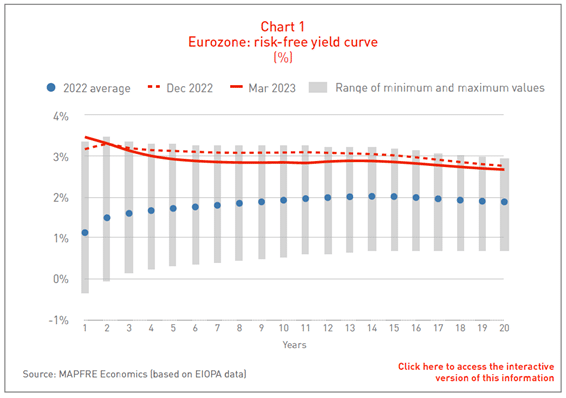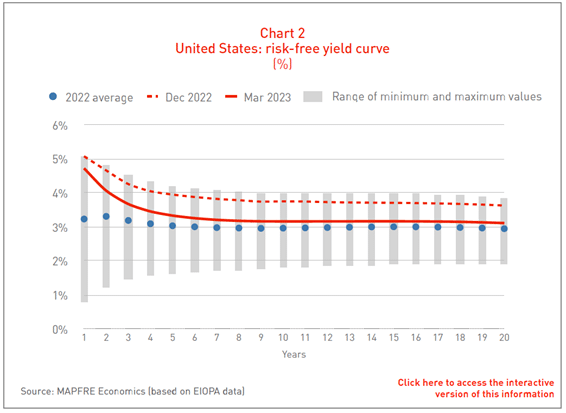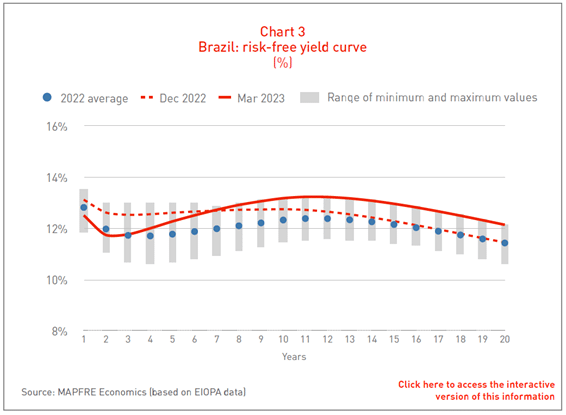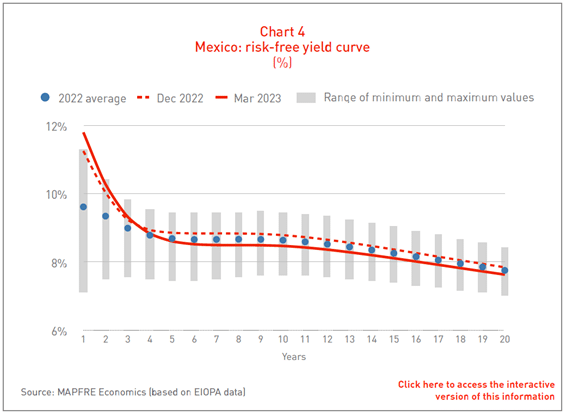Industry outlook for the insurance market (Q2 2023)
In any case, the high levels of risk-free interest rates continue to offer a favorable outlook for the Life Savings business, but the inversion of the interest rate curve has complicated the management of this business, which must adapt to a new environment in which the short-term rates are higher than the long-term rates (negative term premium), which could benefit products with shorter durations and periodic renewals, although more complex for longer-term products, as well as for traditional life annuities.
On the other hand, the S&P 500 index had gained 7.5% through the end of March and the Nasdaq Composite 17.7%. This partial recovery of equity indexes can help the development of life insurance products in which the policyholder assumes the investment risk, which is very common in the US market. This can also take advantage of the higher profitability offered by fixed income in the combination of products launched on the market.
Among the emerging markets, in Brazil, the tightening of financial conditions due to the restrictive monetary policy implemented by the central bank is being transferred to the real economy, which is slowing down, with inflation continuing to moderate. This may lead to a downturn in the insurance market, mainly in the Non-Life segment, although the normalization of supply chains and energy prices has boosted the automotive sector, increasing production and new vehicle registrations, with the positive effect that this entails for the auto insurance segment. Regarding the interest rate environment, which is highly relevant for the insurance business due to the extensive development of Life Savings insurance in the Brazilian market, it is worth noting that the central bank once again decided to keep interest rates at 13.75% in their meetings in February, March and April (the sixth consecutive time) with inflation that continues to decline, entering the upper part of its target range in March (for the first time in two years). This positive real interest rate environment is still favorable for conducting the life savings and annuities business, with interest rates offering returns significantly higher than the latest inflation data.
In the EIOPA risk-free yield curves corresponding to the end of March (see Chart 3), a drop is observed in the short and medium segments of the curve up to maturities of less than seven years. There is a small negative slope in its initial segments, which continues to favor the development of products backed with short-maturity sovereign bonds, very common in this market (VGBL and PGBL). The option of entering into bonds with longer durations is even more attractive, taking advantage of the increase in the level of interest rates in the longest segments, which remain above the short rates (positive term premium in the long segments).
In the case of Mexico, while still in a situation of weak economic dynamics, GDP growth expectations for 2023 improve slightly, estimated at around 1.2% (3.1% in 2022). Even in a fragile economic environment, the activity levels could improve by 2024 when GDP growth could be around 1.5%. The Mexican economy continues to feel the effect of the high interest rates raised again in the last meetings of the Bank of Mexico, maintaining a restrictive monetary policy as long as inflation does not show clear signs of returning to its target range. This may lead to a downturn in the insurance market, mainly in the Non-Life segment, although (as has happened in other countries) the normalization of supply chains and energy prices has boosted production in the automotive sector, improving exports and new vehicle registrations, with the positive effect that this entails for the auto insurance segment. Meanwhile, the moderation of inflation (6.85% in March, compared to 7.9% average inflation in 2022) and the higher profitability of investment portfolios could help improve the profitability of the insurance industry this year.
Regarding the interest rate environment, the Bank of Mexico decided to apply two additional increases in the reference monetary policy interest rate in February and March of 50 and 25 basis points, respectively, leaving it at 11.25%. Thus, in the risk-free yield curves produced by EIOPA (see Chart 4), a slight rise is observed in the shortest segments of the curve with maturities of up to four years, significantly inverted in these segments, as well as a slight drop and a flatter curve in the longer segments. Therefore, this interest rate environment continues to be appropriate for the development of Life Savings insurance, which can offer significantly higher remuneration than the latest inflation data. The inversion in the interest rate curve remains favorable for launching savings products with shorter-term rate guarantees and periodic reviews of guaranteed rates.
In Spain, economic growth expectations for 2023 are estimated at 1.7% (5.5% in 2022), which would lead to exceeding the pre-pandemic production level this year. The recovery of tourism, moderation of energy prices and normalization of supply chain problems are helping this improvement, particularly in certain sectors of activity, such as the automobile industry, improving exports and new vehicle registrations, favoring the recovery of the auto insurance business.
However, it is still an environment of weak economic activity, as a result of the tightening of financial conditions for households and companies, which will continue as long as inflation shows no clear signs of easing throughout the Eurozone economy. This environment points to more moderate growth for the insurance business and better prospects for its profitability throughout the year if inflation continues to moderate. The forecast for 2024 is that the Spanish economy will continue to slow down, with estimated growth of 1.4%, as the effects of the tightening of financing conditions are transferred to the real economy, which may also weigh on the growth of the insurance industry.
Full analysis of the economic and industry perspectives with additional information and interactive charts on the Eurozone, Germany, Italy, Spain, the United Kingdom, the United States, Brazil, Mexico, Argentina, Turkey, Japan, China and the Philippines can be found in the report entitled 2023 Economic and Industry Outlook: Second Quarter Perspectives, compiled by MAPFRE Economics and available at the following link:








